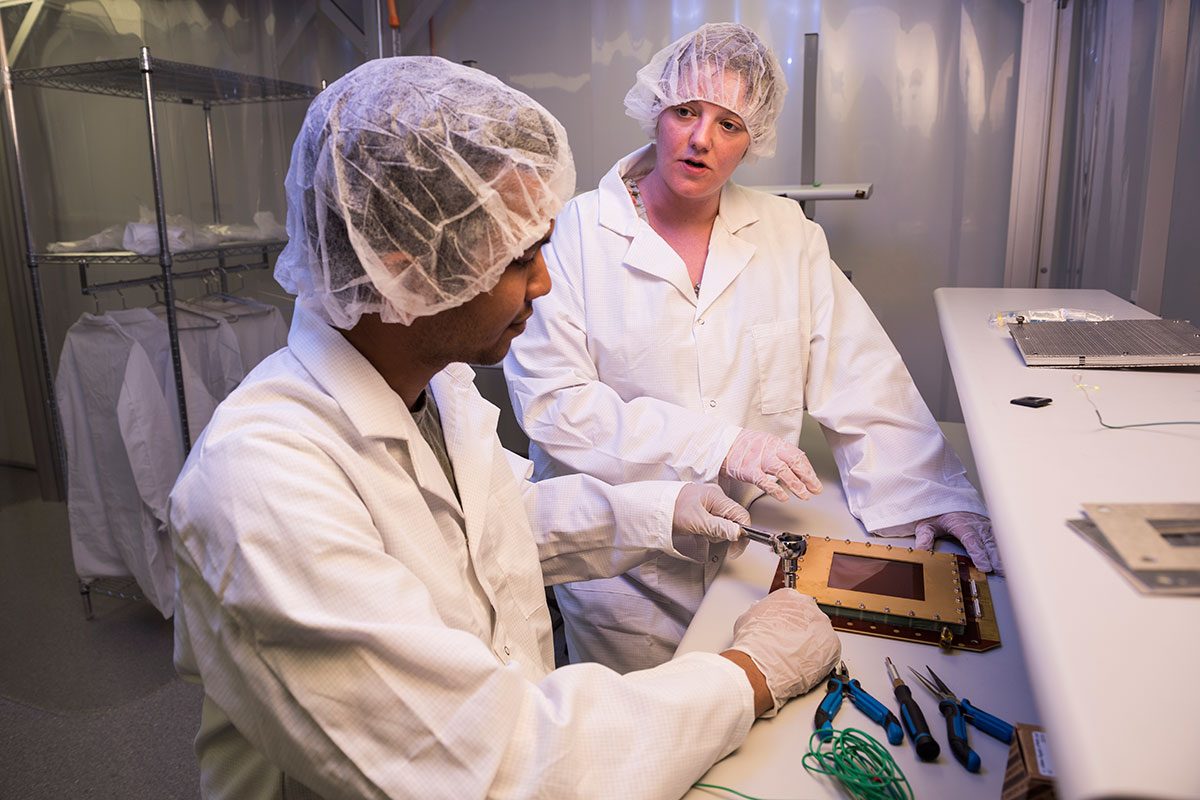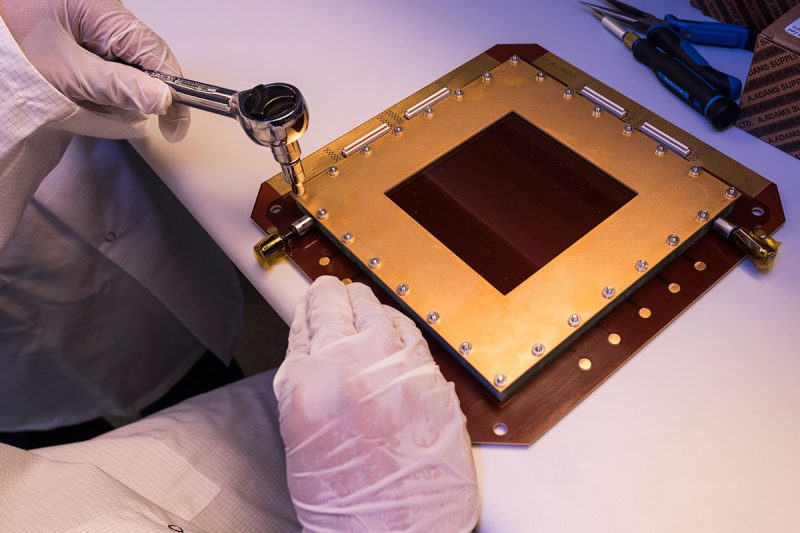
Sakib Rahman, a second year PhD student with Mammei in the clean lab. // Photo by David Lipnowski
Big plans for going small
Subatomic physics at the U of M
Juliette Mammei does research on fundamental symmetries in subatomic nuclear and particle physics. She is seeking answers to one of the world’s most fundamental questions: “What are we made of?”
She explains: “The Standard Model of particles and interactions summarizes our current knowledge of fundamental particles and the types of interactions they can undergo. Using particle detectors, subatomic physicists perform experiments at accelerator facilities that allow them to test the Standard Model and to measure properties of nuclei and nucleons. They accelerate electrons up to velocities close to the speed of light, slam them into a target and then measure the scattered electron properties to learn about the particles in the target.”
“This is pure research—some of the most fundamental research that can be done,” she adds.
The Standard Model is a comprehensive theory that explains what everything in the universe is made of (including us) and what holds everything together. Although physicists have discovered many hundreds of particles and complex interactions, it all boils down to a universe made up of only six quarks, six leptons (such as the electron), their anti-particles and a few “force carrier” particles (like the photon). All other particles are combinations of quarks and leptons, and they interact by exchanging force carrier particles.

Examining the inside of a gas electron multiplier (GEM) detector in the clean room to avoid exposure to dust. Made of planes of mylar vacuum windows and sheets with holes that amplify the electric fields.
The Standard Model is a pretty good theory; experiments have verified it with a high degree of accuracy, and all the particles predicted by it have been detected. But it’s not complete, because it leaves some things out, such as gravity. Physicists are not sure how that fits into the Standard Model. Also, about 95 per cent of the universe is made of material called dark matter, which doesn’t interact with other particles and doesn’t give off light (hence its name).
So there’s still much work to be done on testing the Standard Model, such as looking for new particles or by making more precise measurements. Both of these approaches require more powerful devices or more accurate instruments.
This is complemented by strategic theoretical efforts and supported through agreements with the TRIUMF National Laboratory and international facilities including Argonne and Jefferson Labs (U.S.). A new collaboration has also been formed recently to do experiments in fundamental neutron physics at the Spallation Neutron Source in Oak Ridge, Tennessee. The group plays a leadership role in large collaborations including a proposal to create a world-leading ultra-cold neutron facility at TRIUMF.
Mammei is working to develop highly sensitive detectors in a “clean space” that can then be used in large multinational subatomic physics experiments designed to search for physics beyond the Standard Model and answer the question of what makes up the universe.
The immense scope of her projects require collaboration with researchers and dozens of institutions from around the world, including the U.S. Germany, Italy and France. She works with groups at Jefferson National Laboratory on Qweak and PREX II experiments, and with laboratories in the U.S. and Japan on fundamental neutron experiments.
Moller, a proposed experiment to make ultra-precise measurements of the weak charge of the electron, is one of the internationally recognized discovery potential experiments to be run with collaborators at Jefferson Labs with Mammei as the Canadian principal investigator. The project is part of the Subatomic Physics Long-Range Plan of the Natural Sciences and Engineering Research Council of Canada.
“These experiments are highly collaborative because they require massive efforts in manpower (or womanpower) as well as infrastructure and funding,” says Mammei. “The diverse international collaborations allow for different perspectives to be brought to bear on these fundamental questions. The University of Manitoba has a very strong reputation in the field of ‘Beyond the Standard Model’ physics, particularly in the international electron scattering community. It is one of the reasons I came here—to work with the Jefferson Lab group that has and continues to be essential to the development of the magnetic spectrometers, beam diagnostics and detector development necessary for advancements in this field.”
Through the dedication of subatomic physicists such as Mammei, complimented by a team of internationally recognized scientists and graduate students in the university’s department of physics and astronomy, and in concert with researchers literally around the world, the University of Manitoba could be on the verge of discovering of something really small—with big implications for the universe.
Research Legacy
Manitoba Physics Group History
The Manitoba Subatomic Physics Group is the pre-eminent university-based group in this field within Canada.
- Faculty of Science established in 1904 with physics among one of its first programs.
- Department of Physics established in 1912.
- First graduate degree in physics in 1922 and first PhD awarded in 1930.
- Department of Mathe-matical Physics created in 1950.
- By 1956 the physics department had become a leading centre in Canada for nuclear spectroscopy and its applications.
- Clyclotron planning began in 1957, and construction in 1959, underneath the parking lot beside the Allen Physics building that was concurrently under construction.
- The Allen [physics] Building opened in 1960.
- The cyclotron facility officially opened in 1965.
- It was the second cyclotron in Canada and the first in Western Canada. The U of M cyclotron was considered a pioneer model of cyclotron design during that period, and was the only negative hydrogen ion cyclotron operating between 20 MeV and 50 MeV in North America. It produced beams of high quality and intensity in order to tackle some of the problems in atomic and subatomic physics.
- The ion source was housed in a building at ground level while the cyclotron was situated two floors below. The cyclotron vault, the shielding and the two experimental areas together occupied 5,000 square feet, while the control room and the electrical room took up another 2,000 square feet of floor area.
- From 1965 to 1985, the cyclotron attracted many physicists, engineers and students to the university to help assist with the project and made it a major turning point within the department.
- In 1986, under the directorship of Dr. Jasper McKee, the cyclotron’s uses expanded to other areas of research other than nuclear physics and the Cyclotron Laboratory changed its name to Accelerator Centre to serve as the University Research Centre where interdisciplinary and applied research could be carried out in conjunction with external laboratories and/or the private sector.
- The Accelerator Centre ceased operation in 1989. In 2016, the Manitoba Institute for Materials was constructed in its location.
Research at the University of Manitoba is partially supported by funding from the Government of Canada Research Support Fund.






